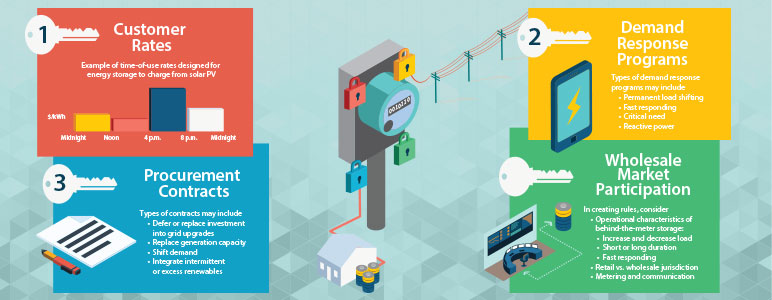Unlocking the Value of Behind-the-Meter Energy Storage

In 2010, California became the first state to mandate energy storage procurement with targets for each major investor-owned utility with the objective of reducing greenhouse gas (GHG) emissions, cutting peak electric demand, deferring or substituting for investments in generation or grid assets and improving overall grid reliability.
Ultimately, the California Public Utilities Commission ruled that the utilities should secure 1,325 megawatts (MW) of energy storage systems by 2020 and that systems funded through California’s Self-Generation Incentive Program (SGIP) would count toward this goal. Since 2011, the SGIP has funded more than 71 MW of behind-the-meter energy storage projects, with an additional 40 MW in the queue.
Read CSE’S white paper: Maximizing the Grid Benefits of Behind-the-Meter Energy Storage
Even with this boost in deployment, behind-the-meter energy storage systems have not reached their potential for maximum value to the grid. CSE examines why and what policy reforms are needed and most integral to exploit their value to both customers and the grid in a policy white paper, Maximizing the Grid Benefits of Behind-the-Meter Energy Storage.
The intent of the new paper is to inform and assist policymakers, utilities and other stakeholders in establishing clear expectations and goals for behind-the-meter energy storage, which would allow these technologies to play a more effective role in decarbonizing our electricity system and increasing the efficiency and reliability of the grid.
The paper investigates four principal financial signals – tariffs, demand response programs, utility procurement contracts and direct wholesale market participation – that can be developed by local, state and national entities to promote more efficient uses of behind-the-meter energy storage systems. The recommendations are applicable not only within California but to any entities seeking to integrate behind-the-meter energy storage into their energy system, whether at the local, state or national level.
Financial Signal #1: Tariffs
As energy storage systems are designed to operate according to price signals, tariffs (utility rates) can be designed to allow systems to accomplish specific functions. For example, if a utility experiences daily or seasonal peak demand, tariffs such as coincident peak demand charges or peak energy prices can be designed to encourage energy storage systems to shift peak demand to off-peak hours. Properly designed tariffs will send price signals to energy storage systems, indicating how and when these systems should be operated to produce the most benefit for the grid and, consequently, the customer.
Financial Signal #2: Demand response programs
Demand response programs have the advantage over tariffs of being much more dynamic and specific to the needs of the grid, especially in critical locations. Because energy storage can both increase and decrease load, storage could be called upon to charge if there is excess generation on a specific feeder and then discharge the energy later when needed. Further, multiple systems located at different customer properties can be aggregated and operated as a fleet.
Financial Signal #3: Procurement contracts
Utility contracts can be used to procure energy storage systems that will operate to achieve specific purposes. These contracts are typically very attractive for project developers as they offer specific terms and conditions and bankable financial return, whereas tariffs or demand response programs might not offer such features. Additionally, contracts offer a firm commitment from storage system operators so that utilities can depend on these resources.
Financial Signal #4: Participation in wholesale markets
Wholesale markets send price signals that can be roughly equated to the needs of the grid. Energy storage can take advantage of these opportunities by charging when and where prices are low and generation is relatively abundant and discharging when prices are higher, thus reducing the need to generate additional energy. Furthermore, many energy storage technologies can respond almost instantly to signals to charge or discharge energy, making these technologies good candidates to provide ancillary services such as frequency regulation.
Final considerations
Customer tariffs, demand response programs, procurement contracts and wholesale market participation are not independent of each other. A single resource can participate and be affected by several, if not all, of these financial signals, and payments for services should be made accordingly for additional value that storage systems provide. The overarching goal should be to grant storage systems more opportunities to provide their value and compensate them for doing so.
Behind-the-meter storage systems will respond to the signals that provide the highest financial return. Thus, the financial return should be highest for the services that are most needed to encourage systems to provide these services. In implementing price signals that encourage behind-the-meter storage systems to respond to grid needs, these systems can be used to provide the greatest value at places and times that most need it to the benefit of host customers, the grid and all ratepayers.

